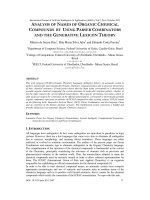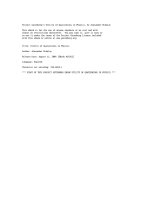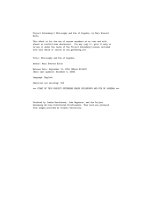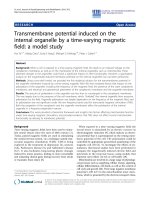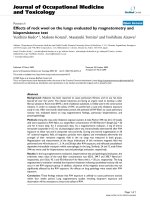Project Gutenberg''''s On the Antiquity of the Chemical Art, by James Mactear pptx
Bạn đang xem bản rút gọn của tài liệu. Xem và tải ngay bản đầy đủ của tài liệu tại đây (374.99 KB, 151 trang )
Project Gutenberg's On the Antiquity of
the Chemical Art, by James Mactear
This eBook is for the use of anyone
anywhere at no cost and with
almost no restrictions whatsoever. You may
copy it, give it away or
re-use it under the terms of the Project
Gutenberg License included
with this eBook or online at
www.gutenberg.org
Title: On the Antiquity of the Chemical
Art
Author: James Mactear
Release Date: February 11, 2006 [EBook
#17753]
Language: English
*** START OF THIS PROJECT GUTENBERG EBOOK
ANTIQUITY OF THE CHEMICAL ART ***
Produced by Louise Hope, R. Cedron and the
Online
Distributed Proofreading Team at
A few
typographical
errors have
been
corrected.
They have
been marked
in the text
with mouse-
hover
popups.
Misspellings
in Greek
names were
treated as
errors;
others are
noted but not
changed.
PRESIDENT’S OPENING ADDRESS
TO CHEMICAL SECTION.
ON THE ANTIQUITY
OF
THE CHEMICAL
ART.
By JAMES MACTEAR, F.C.S.,
F.C.I.
THE PRESIDENT’S
OPENING ADDRESS TO
THE CHEMICAL SECTION.
On the Antiquity of the
Chemical Art. By James
Mactear, F.C.S., F.C.I.,
Member of the
International Jury, Paris,
1878,
and Medalist of the Society
of Arts.
[Read before the Section, December 8th, 1879.]
The study of the History of Chemistry as
an art, or as a science, is one which
possesses peculiar fascination for its
votaries. It has been the subject of deep
research and much discussion, much has
been written upon the subject, and many
theories have been broached to account
for its origin. We have had laid before us
by Professor Ferguson, in his papers on
this subject of Chemical History, very
clearly and fully the generally-accepted
position as regards the origin of the
science, and in the last of these papers,
entitled “Eleven Centuries of Chemistry,”
he deals with the subject in a most
complete manner, tracing back through its
various mutations the development of the
science to the time of Geber, in or about
the year A.D. 778.
Of Geber, as a chemist, Professor
Ferguson writes, “He was the first—
because, although he himself speaks of the
ancients, meaning thereby his forerunners,
nothing is known of these older chemists.”
Rodwell, in his “Birth of Chemistry,”
after a careful examination of the question,
comes to the conclusion that, “in spite of
all that has been written on the subject,
there is no good evidence to prove that
alchemy and chemistry did not originate in
Arabia not long prior to the eighth century,
A.D.,” bringing us again to the times of
Geber.
He is not alone in this opinion, and it
seems to be generally accepted that
chemistry originated in the Arabian
schools about this period.
In dealing with the question of the
antiquity of chemical art, it has been too
much the habit to look at the question with
a view of discovering when and who it
was that first brought forth, fully clothed
as a science, the art of chemistry.
Let us look at the definition of the science
given by Boerhæve, about 1732. He
describes chemistry as “an art which
teaches the manner of performing certain
physical operations, whereby bodies
cognizable to the senses, or capable of
being rendered cognizable, and of being
contained in vessels, are so changed by
means of proper instruments as to produce
certain determinate effects, and at the
same time discover the causes thereof, for
the service of the various arts.”
Now, it is amply evident that, long before
the various known facts could be
collected and welded into one compact
whole as a science, there must have
existed great store of intellectual wealth,
as well as mere hereditary practical
knowledge of the various chemical facts.
I do not think it will be disputed that, until
comparatively recent times, technical
knowledge has constantly been in advance
of theory, and that it is not too much to
conclude that, no matter where we first
find actual records of our science, its natal
day must have long before dawned. Even
in our day, when theoretical science, as
applied to chemistry, has made such
immense strides, how often do we find
that it is only now that theory comes in to
explain facts, known as such long
previous, and those engaged in practical
chemical work know how much technical
knowledge is still unwritten, and what
may even be called traditionary.
I purpose taking up the subject from this
point of view, and attempting, with what
little ability I can, to follow back to a still
more remote period than that of Geber and
the Arabian school of philosophers the
traces of what has often been called the
divine art.
An aspect of the question that has often
presented itself to me is this, that the
history of what we call our world extends
over some 4000 years before Christ and
1878 years since, so that, according to the
usually accepted idea, if chemistry
originated in Arabia in the eighth century,
it was not known during say the first 5000
years of the world’s history, but has
advanced to its present high position
amongst the sciences in the last 1000
years.
I hope to be able to show that, while the
Arabian school of philosophy get the
credit of originating most of the sciences,
that it is as undeserved in the case of
chemical science as in that of astronomy
or mathematics. At the same time let us not
undervalue the services rendered to
science by this school: it is to them we
owe the distribution of the knowledge of
most of our sciences, and the Arabic
literature of most of these was widely
spread abroad over all the known world
of their time.
The central portion of Baghdad between
the eastern and western portions of the
Old World, and the wise and enlightened
policy of its rulers, which welcomed to its
schools, without reference to country or
creed, the wise and learned men of every
nation, drew to it as to a centre the
accumulated wisdom and knowledge of
both the rising and the setting sun. Long
ere this time, however, we find, as
regards the Greeks, that they constantly
travelled eastward in search of learning,
while we know that the expedition of
Alexander the Great, about B.C. 327, in
which he traversed a considerable portion
of India, had already opened up the store-
houses of Indian lore to the minds of the
West.
In connection with this, the following
extract from an old book: called The
Gunner, dated 1664, is interesting:—
“In the life of Apollonius Tyanæus,
written by Philostratus 1500 years ago,
we find, in reference to the Indians called
Oxydra: These truly wise men dwelled
between the rivers Hyphasis and Ganges;
their country Alexander the Great never
entered, being deterred, not by fear of the
inhabitants, but, as I suppose, by, religious
considerations, for had he passed the
Hyphasis, he might doubtless have made
himself master of the country all round
him; but their cities he could never have
taken, though he had led a thousand as
brave as Achilles or ten thousand such as
Ajax to the assault. For they come not out
into the field to fight those who attack
them; but these holy men, beloved of the
gods, overthrow their enemies with
tempests and thunder-bolts shot from their
walls.
“It is said that Egyptian Hercules and
Bacchus (Dionysius), when they overran
India, invaded this people also, and
having prepared warlike engines,
attempted to conquer them. They made no
show of resistance, but upon the enemy’s
near approach to their cities they were
repulsed with storms of lightning and
thunder hurled upon them from above.”
May we not here have the original of the
Greek fire, that was in its day so
celebrated and so destructive?
Beginning then at the period of Geber,
about 776 A.D., let us try to work
backwards and trace, if we can, the
progress of chemical knowledge down the
stream of time.
While the Western Roman Empire had
fallen, the Eastern still held its sway as far
as the rivers Tigris and Euphrates, and
continued the contest with the Persian
power for the supremacy in Asia. At this
time the various creeds and beliefs of the
Arabian tribes—which had been much
influenced by the settlement amongst them
of Jews who had been dispersed at the
time of the destruction of Jerusalem, and
many of the sects of Christians who had
been driven from the Roman empire by the
more orthodox—were deeply stirred by
the new doctrine of Islam, preached by
Mahomet, A.D. 622, proclaiming the Koran
as the rule of life, and the destruction of
the ancient Arabian worship of the stars
and sun and moon.
The religion of “the one God and
Mahomet his prophet” took deep root, and
the injunction to pursue the unbelieving
with fire and sword was followed out
with such unrelenting vigour that, within
less than a century from the death of
Mahomet, the Arabian power had
extended its sway amongst nearly every
tribe and nation that had owned the rule of
the Roman or Persian empires, and had
reached from Spain to India, from
Samarcand to the Indian Ocean.
Egypt and Syria were conquered between
A.D. 632-39, and Persia about A.D. 632-
51. Their attempts to take Constantinople
by siege failed both in A.D. 673 and 716.
But they were more successful on the
African shores of the Mediterranean,
which they swept along till they crossed
the Straits of Gibraltar and entered Spain
in A.D. 709. Their further progress—
through France—was stayed by their
defeat in a great battle fought at Tour’s,
when the Gauls, under Charles Martel,
forced them to retire ultimately across the
Pyrenees.
Internal dissension had, however, arisen
amongst them, and the ruling dynasty of the
Ommiades was overthrown in A.D. 750 by
the Abassides, who established
themselves at Damascus; and with them
began that cultivation of the arts and
sciences which has thrown such lustre on
the Arabian school.
One of the princes of the Ommiades who
had escaped made his way to Spain and
there re-established the power of his
family, with Cordova as a centre, about
A.D. 755. Thus it was that the Saracenic
power was divided into an Eastern and a
Western Caliphate.
It was under the prosperous rule of the
Abassides that such an impulse was given
to learning of every kind, and that the
Arabian school of philosophy, which has
left behind it such glorious records of its
greatness, was founded. The Caliph Al-
Mansour was the first, so far as we know,
who earnestly encouraged the cultivation
of learning; but it was to Haroun Al-
Raschid, A.D. 786-808 (?), that the
Arabians owed the establishment of a
college of philosophy. He invited learned
men to his kingdom from all nations, and
paid them munificently; he employed them
in translating the most famous books of the
Greeks and others, and spread abroad
throughout his dominions numerous copies
of those works.
His second son, Al-Mamoon, while
governor of the province of Kohrassan,
we are told, formed a college of learned
men from every country, and appointed as
the president John Mesue, of Damascus. It
is said that his father, complaining that so
great an honour had been conferred on a
Christian, received the reply—“That
Mesue had been chosen, not as a teacher
of religion, but as an able preceptor in
useful arts and sciences; and my father
well knows that the most learned men and
the most skilful artists in his dominions
are Jews and Christians.”
That this was the case can scarcely be
doubted when we consider that the Jews
had always been familiar with many arts
and sciences, and that, as is well known,
at the destruction of Jerusalem in A.D. 70,
when the Jews were dispersed in every
direction, they spread over, not alone the
countries under the Roman rule, but to
Greece, Egypt, and the Mediterranean
coast, as well as great part of Asia Minor,
carrying with them, not only their peculiar
religious traditions, but also their arts,
which, we know, especially as regards the
working of metals, were of no mean order,
and their sciences, of which the so-called
magic and astrology had been assiduously
cultivated.
In Asia the dispersed Jews established
patriarchates at Tiberias in the west, and
at Mahalia, and afterwards at Baghdad,
for the Jews who were beyond the
Euphrates.
Seminaries were founded at these centres
for the rabbis, and constant intercourse
was kept up between them. It was in these
schools that the Talmud was compiled
from the traditionary exposition of the Old
Testament, between A.D. 200 and A.D. 500,
when it was completed, and received as a
rule of faith by most of the scattered Jews.
That the cultivation of science was not
neglected we may be sure from the keen
interest taken in all ages by the Jews in
magical and astrological inquiries. We
read in Apuleius, in his defence on the
accusation of magic brought against him,
that of the “four tutors appointed to
educate the princes of Persia, one had to
instruct him specially in the magic of
Zoroaster and Oromazes, which is the
worship of the gods.” Apuleius wrote
about 200 A.D., and his works teem with
references to magic and astrology.
The fact that Jews and Christians were
looked on as learned men will not
surprise us, when we find that the Jews
had established schools so long anterior to
the foundation of the college of Baghdad.
The rapid progress made by the Arabians,
and the wise policy of the Abasside
Caliphs, under whose judicious rule
learning was so liberally encouraged,
aided by the position of Baghdad, which
formed, as it were, a centre to which the
wisdom of both eastern and western minds
gravitated, attracted to their schools all
those of every nation who boasted
themselves philosophers.
The first translations from the Greek
authors are supposed to have been made
about A.D. 745, and are known to have
been on the subjects of philosophy,
mathematics, astronomy, and medicine.
These translations are understood to have
been made by Christian or Jewish
physicians.
As we have seen, the Jews had already
established themselves at Baghdad, and
had founded schools of their own previous
to the formation of the college under
Caliph Al-Mansour; but further than this
we find the Christians spread widely over
the countries of Asia Minor, and we are
told, on the authority of Cosmo-
Indicopleustes, that so early as A.D. 535
there was in almost every large town in
India a Christian Church under the Bishop
of Seleucia.
With these facts before us—1st, that
